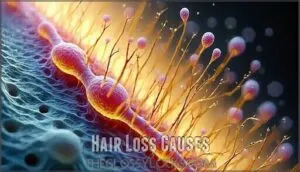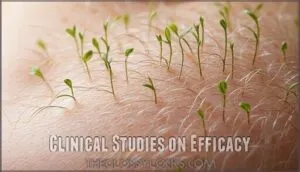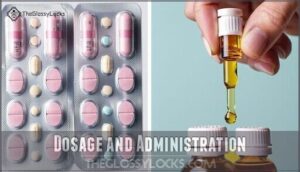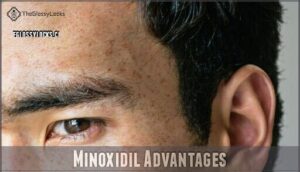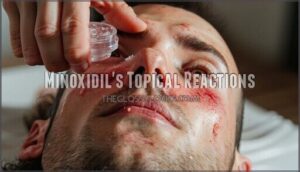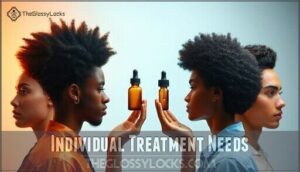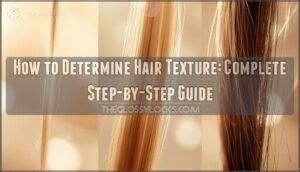This site is supported by our readers. We may earn a commission, at no cost to you, if you purchase through links.
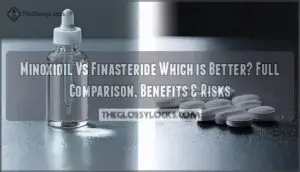
Finasteride blocks DHT—the hormone that shrinks hair follicles—making it more effective at preventing further hair loss. Clinical studies show it’s superior to minoxidil for stopping male pattern baldness progression.
However, minoxidil works by increasing blood flow to follicles, helping regrow hair you’ve already lost. It’s available over-the-counter and has fewer systemic side effects, while finasteride requires a prescription and may cause sexual side effects in some men.
Your age, hair loss pattern, and risk tolerance all factor into which treatment suits you best, though many find combining both approaches yields the best results.
Table Of Contents
- Key Takeaways
- Minoxidil Vs Finasteride
- Hair Loss Causes
- Finasteride Benefits
- Minoxidil Advantages
- Combination Therapy
- Side Effects Comparison
- Cost and Availability
- Treatment Duration
- Individual Treatment Needs
- Choosing The Best Option
- Frequently Asked Questions (FAQs)
- Is it better to take finasteride or minoxidil?
- Which has worse side effects, minoxidil or finasteride?
- Why don’t more men use finasteride?
- Why do doctors recommend finasteride?
- Is minoxidil better than finasteride?
- Are finasteride and minoxidil effective for hair loss?
- How does minoxidil & finasteride work?
- How many people use finasteride & minoxidil?
- Can women use Finasteride for hair loss?
- How long after stopping treatment does hair loss resume?
- Conclusion
Key Takeaways
- You’ll get better hair loss prevention with finasteride since it blocks DHT—the hormone that causes follicles to shrink—making it more effective at stopping male pattern baldness progression than minoxidil alone.
- Minoxidil works better for regrowing hair you’ve already lost because it increases blood flow to your follicles, while finasteride primarily prevents future loss rather than reversing existing damage.
- Side effects differ significantly between treatments—minoxidil causes mainly scalp irritation and itching, while finasteride can trigger sexual side effects in 2-4% of men, though most reverse when you stop taking it.
- Combining both treatments gives you the best results since they work through different mechanisms, with studies showing 92.4% of patients achieve stabilized or improved hair density when using finasteride and minoxidil together.
Minoxidil Vs Finasteride
When you’re deciding between minoxidil and finasteride for hair loss, it’s important to know how each works and what results you can expect.
Both medications target hair growth differently, so understanding their mechanisms, effectiveness, and side effects helps you choose the best option for your needs, which involves considering how each treatment affects hair growth.
Mechanism of Action
When you compare minoxidil and finasteride, their core actions differ.
Minoxidil is a vasodilator, boosting scalp blood flow and nutrient delivery, stimulating follicles, and prolonging the anagen phase.
Minoxidil opens blood vessels, feeding your follicles the nutrients they need to thrive and grow stronger hair.
Finasteride, a 5-reductase inhibitor and DHT blocker, stops testosterone from converting to DHT, the main culprit in hair loss.
| Mechanism | Minoxidil | Finasteride |
|---|---|---|
| Vasodilation | Yes | No |
| DHT Inhibition | No | Yes |
| Follicle Stimulation | Yes | Indirect via DHT reduction |
Effectiveness Comparison
When weighing hair regrowth rates and long-term results, finasteride often outshines minoxidil, especially in advanced baldness stages.
Combination efficacy is highest—using both boosts patient satisfaction and hair density.
Finasteride functions by inhibiting DHT production, a key factor in androgenetic alopecia.
Check out this quick table for clarity:
| Treatment | Effectiveness | Patient Satisfaction |
|---|---|---|
| Minoxidil | Moderate | Moderate |
| Finasteride | High | High |
| Combo Therapy | Very High | Very High |
Using both minoxidil and finasteride can lead to very high patient satisfaction and hair density, making it a preferred treatment option for many.
Side Effects Profile
After reviewing effectiveness, it’s smart to weigh side effects.
Minoxidil side effects usually stick to the scalp—think itching, dryness, or rare allergic reactions.
Finasteride side effects can be more widespread, including sexual dysfunction and other systemic effects.
Long-term risks exist for both, so check this table for a quick summary:
| Drug | Common Side Effects | Long-Term Risks |
|---|---|---|
| Minoxidil | Topical reactions, itching | Allergic reactions |
| Finasteride | Sexual side effects | Systemic effects |
| Both | Rare allergic reactions | Side effects (review) |
Hair Loss Causes
When you notice thinning hair or a receding hairline, it’s often due to a mix of genetics, hormones like dihydrotestosterone (DHT), and environmental factors.
Understanding these causes helps you choose the most effective treatment for your specific type of hair loss.
Male Pattern Baldness
Male pattern baldness is the most common cause of hair loss in men, driven by genetics and age.
You’ll notice thinning at the crown or a receding hairline.
Key factors that affect hair follicle health include:
- Scalp microbiome imbalances
- Nutritional deficiencies
- Chronic stress impact
- Poor sleep quality
Treatments like minoxidil and finasteride target these underlying issues, supporting healthier hair growth.
DHT’s Role in Hair Loss
As hair thins and recedes, DHT—short for dihydrotestosterone—steps into the spotlight.
DHT production, driven by the 5-reductase enzyme, binds to androgen receptors in scalp follicles.
If your follicles are sensitive, DHT triggers hair miniaturization, shrinking strands over time.
Finasteride acts as a 5reductase inhibitor, lowering DHT levels, while minoxidil supports growth without affecting DHT itself.
Genetic and Environmental Factors
Every person’s hair loss journey is unique, but certain factors play a big role.
Here’s what you should watch:
- Genetic Predisposition—your family history often decides your risk.
- Environmental Triggers—pollution, harsh chemicals, and daily habits can speed things up.
- Stress Impact and Nutritional Deficiencies—stress and poor diet disrupt your scalp microbiome, making minoxidil or finasteride less effective.
Finasteride Benefits
When you use finasteride, you target the root cause of male pattern baldness by blocking DHT, the hormone responsible for shrinking hair follicles.
Clinical studies show that daily use can slow hair loss and even promote new growth, making it an effective option for many men, as it addresses the underlying issue of hair loss.
DHT Blocking
Through powerful hormonal intervention, finasteride blocks 5-alpha-reductase enzyme, preventing testosterone conversion into dihydrotestosterone.
This DHT Reduction creates Systemic Effects throughout your body, lowering serum DHT levels by approximately 70%.
However, Pregnancy Risks and potential Liver Impact require careful consideration before starting treatment.
| DHT Blocking Aspect | Finasteride Effect |
|---|---|
| DHT Reduction Rate | 70% serum decrease |
| Enzyme Target | 5-alpha-reductase |
| Action Type | Systemic hormone blocker |
| Coverage Area | Entire scalp/body |
| Hormonal Impact | Testosterone pathway disruption |
Clinical Studies on Efficacy
Clinical studies demonstrate finasteride’s remarkable track record in combating hair loss.
Clinical trials prove finasteride works—results speak louder than promises.
Research spanning multiple years reveals consistent patient outcomes and long-term results that set the gold standard.
Key clinical findings include:
- Hair count increases: 11% improvement at one year, maintained through two years
- Patient satisfaction: 60.86% reported improved hair appearance versus 18.75% placebo
- Long-term success: 65% showed increased hair count at five years
- Progression control: 90% maintained or improved scalp coverage
- Early results: Visible improvements often appear within three months
These combination studies and effectiveness data position finasteride as a proven treatment option.
The medication works by inhibiting the 5-alpha reductase enzyme.
Dosage and Administration
For maximum hair retention, you’ll take finasteride as a 1mg oral tablet daily, with or without food.
Unlike topical minoxidil requiring twice-daily application, finasteride’s once-daily dosage simplifies treatment adherence.
Combination products aren’t available, so you’ll manage separate medications if using both treatments together for enhanced results.
Many users easily purchase finasteride 1mg online.
Minoxidil Advantages
While finasteride targets the hormonal root of hair loss, minoxidil offers unique advantages that make it an attractive treatment option for many people experiencing hair thinning.
You’ll find that minoxidil’s topical application and direct scalp action provide benefits that complement or sometimes surpass finasteride’s systemic approach, making it a valuable choice with its own set of advantages.
Topical Application
Applying topical minoxidil directly to your scalp offers distinct advantages over systemic treatments.
You control exactly where the medication goes, targeting specific areas of hair loss while minimizing whole-body exposure.
- Application Frequency: Twice-daily dosing maintains consistent scalp coverage
- Absorption Rates: Direct follicle contact maximizes localized effectiveness
- Scalp Health: Gentler approach reduces systemic side effects
- User Experience: Simple routine fits easily into daily grooming habits
Vasodilation and Blood Flow
Minoxidil works as a powerful vasodilator, directly opening blood vessels to boost scalp circulation and enhance nutrient delivery to struggling hair follicles.
This increased blood flow creates an ideal environment for follicle stimulation, unlike finasteride which doesn’t affect blood vessel health.
Through topical absorption, minoxidil transforms your scalp’s vascular landscape, promoting sustained hair growth and enhancing the overall health of the hair follicles by improving blood flow, which is a key factor in hair follicle stimulation.
Available Concentrations
You’ll find minoxidil in several concentrations, giving you flexibility to match your treatment needs.
Lower concentrations work well for beginners, while higher strengths deliver more potent results for advanced hair loss.
- 2% concentration: Recommended for women and sensitive scalps
- 5% concentration: Standard strength for men with proven topical efficacy
- Compounded gels: Custom formulations combining minoxidil with finasteride dosage options
Various websites offer products with minoxidil.
Combination Therapy
You can combine finasteride and minoxidil to tackle hair loss from both angles—blocking DHT while boosting blood flow to follicles.
This dual approach often delivers better results than using either treatment alone, though it also means managing potential side effects from both medications, using a dual approach with finasteride.
Finasteride and Minoxidil Together
When you combine finasteride and minoxidil, you’re targeting hair loss from two angles.
This combination therapy creates synergistic effects, with finasteride blocking DHT while minoxidil enhances blood flow for hair growth.
Many users experience enhanced regrowth compared to using either treatment alone, though proper treatment sequencing matters for ideal long-term outcomes.
Benefits and Risks
When combining finasteride and minoxidil for hair loss treatment, you’ll experience enhanced effectiveness alongside increased risks.
This dual approach targets different pathways, maximizing results while potentially amplifying side effects.
- Systemic Effects: Finasteride affects hormone levels throughout your body, while topical minoxidil primarily acts locally on your scalp.
- Topical Safety: Minoxidil’s localized application reduces systemic exposure, though allergic reactions can still occur at the application site.
- Long-Term Use: Both medications require continuous treatment, with pregnancy risks making finasteride unsuitable for women of childbearing age.
- Effectiveness: Combined therapy shows superior hair regrowth compared to either treatment alone, though individual responses vary substantially.
Patient Satisfaction Rates
Satisfaction rates with combined minoxidil-finasteride therapy reveal impressive outcomes you’ll find encouraging.
Studies show 92.4% of patients achieve stabilized or improved hair density, with 57.4% experiencing marked improvements after twelve months.
| Treatment Outcome | Satisfaction Rate | Key Benefits | Patient Experience |
|---|---|---|---|
| Hair Density Improvement | 92.4% | Stabilized/improved results | Enhanced confidence |
| Marked Progress | 57.4% | Visible growth after 12 months | Better treatment expectations |
| Severe Cases (Norwood 6-7) | High effect size | Significant gains possible | Improved perceived effectiveness |
| Minimal Side Effects | Low occurrence | Safe combination approach | Better side effect tolerance |
Your overall experience depends on realistic treatment expectations and application preferences.
Combination therapy often delivers superior treatment outcomes compared to monotherapy, making patient satisfaction remarkably higher for hair loss management.
Lifestyle adjustments such as reducing overall stress can also improve hair health.
Side Effects Comparison
When weighing treatment options, you’ll want to understand how each medication affects your body differently.
While both treatments can cause side effects, finasteride‘s systemic hormone changes carry different risks than minoxidil‘s localized skin reactions.
Finasteride’s Sexual Side Effects
Sexual side effects from finasteride affect 2-4% of men, with erectile dysfunction being most common.
Most symptoms resolve after stopping treatment, though rare cases persist.
| Side Effect Type | Incidence Rate |
|---|---|
| Decreased Libido | 1.9% – 10% |
| Erectile Problems | 1.4% – 15.8% |
| Ejaculation Disorder | 0.8% – 7.7% |
The reversibility of these sexual dysfunction symptoms offers reassurance—clinical trials show recovery in most cases.
Long-term effects remain controversial, with Post-Finasteride Syndrome affecting a small minority who experience persistent libido impact even after discontinuation.
Minoxidil’s Topical Reactions
While finasteride affects your body systemically, topical minoxidil creates localized reactions at the application site.
You’ll commonly experience scalp irritation, affecting 14-19% of users through burning sensations and skin rashes.
Addressing minoxidil scalp issues can be essential for continued treatment.
Systemic absorption remains minimal, but unwanted facial hair growth can occur from product migration during sleep.
| Common Reactions | Frequency/Severity |
|---|---|
| Scalp irritation | 14-19% of users |
| Skin rashes/burning | Mild to moderate |
| Facial hair growth | Variable, location-dependent |
Reversibility of Adverse Effects
When you stop taking these medications, most side effects reverse—but the timeline differs dramatically.
Minoxidil reactions like scalp irritation typically clear within weeks, while finasteride’s sexual side effects can persist for months or even years in some cases.
| Aspect | Minoxidil | Finasteride |
|---|---|---|
| Reversal Rate | 98% complete recovery | 70-85% complete recovery |
| Timeline | 1-2 months | 3+ months (some permanent) |
| Persistent Dysfunction | Virtually none reported | 1.3-3.8% of users |
| Long-term Effects | Minimal documented cases | Up to 40 months average |
| Discontinuation Impact | Predictable recovery | Variable outcomes |
Cost and Availability
When comparing treatment costs, you’ll find minoxidil offers a clear advantage as an over-the-counter option, while finasteride requires a prescription and regular doctor visits.
Your long-term financial commitment varies substantially between these treatments, with generic versions of both medications helping reduce monthly expenses, though insurance coverage remains limited for cosmetic hair loss treatments.
Prescription Vs OTC
Access barriers substantially differ between these treatments.
You’ll find minoxidil available over-the-counter at most pharmacies, while finasteride requires a doctor’s prescription.
This regulatory oversight creates distinct consumer awareness patterns and formulation differences.
Benzoyl peroxide cleansers can also be found over the counter.
- Minoxidil’s convenience: Walk into any drugstore and grab it off the shelf
- Finasteride’s gatekeeping: Doctor visits and prescription renewals required
- Strength variations: OTC minoxidil offers 2% and 5% concentrations
- FDA regulation: Prescription status reflects stronger regulatory oversight for finasteride
- Consumer freedom: Immediate access versus medical supervision requirements
Long-Term Financial Commitment
Over five years, you’ll spend roughly $1,200-$3,600 on minoxidil versus $600-$1,800 for finasteride.
Generic availability dramatically reduces costs, making Treatment ROI favorable for both options.
Financial Planning becomes essential since discontinued use reverses benefits, requiring Continued Purchase commitments.
| Treatment | Annual Cost | 5-Year Total |
|---|---|---|
| Minoxidil | $240-$720 | $1,200-$3,600 |
| Finasteride | $120-$360 | $600-$1,800 |
Insurance Coverage and Generics
Most insurance plans won’t cover minoxidil or finasteride for hair loss since they’re considered cosmetic.
You’ll find better luck with generic versions that cut costs substantially. Generic minoxidil runs about $22 for three months, while generic finasteride costs much less than brand names.
Check your plan’s formulary status and insurance tiers before purchasing, as this will help you understand the costs involved.
Treatment Duration
Understanding treatment duration helps you plan for realistic expectations when starting either medication.
Both finasteride and minoxidil require long-term commitment, but they differ substantially in their maintenance demands and how quickly you’ll see results.
Finasteride’s Long-Term Efficacy
With finasteride, your hair’s future hinges on consistent DHT suppression over years.
Finasteride results show 65% of men maintain increased hair count at five years, while 90% either sustain or improve scalp coverage.
Patient satisfaction remains high through longterm use, though finasteride side effects affect 3-4% of users.
Dosage adjustments aren’t typically needed.
- Five-year hair count improvements – 277 additional hairs compared to placebo in target areas
- Prevention rates – Only 17% experience continued hair loss versus 72% on placebo
- Sustained DHT reduction – 70% decrease in serum DHT levels maintains effectiveness
- Patient satisfaction scores – Most men report improved hair appearance and slowed loss
- Predictable outcomes – Early responders typically maintain or improve results long-term
Minoxidil’s Maintenance Requirements
Minoxidil requires twice-daily topical application for continued effectiveness, making routine integration critical for long-term use.
You can’t skip days without risking hair loss resumption. The standard dosage remains consistent throughout treatment, though some users adjust application frequency based on scalp tolerance.
Continuous use becomes a permanent lifestyle commitment since stopping minoxidil reverses hair growth gains within months. Many users see increased hair density with consistent use.
Patient Compliance and Persistence
Sticking with hair loss treatment requires serious commitment, but adherence challenges often derail progress.
Minoxidil’s twice-daily dosage frequency creates treatment fatigue compared to finasteride’s simple once-daily pill.
Your perceived effectiveness influences medication adherence substantially, and many patients abandon treatment after six months without dramatic results, despite long-term commitment being essential.
Patient preference varies, and some favor minoxidil’s topical application over systemic medication, while others prefer finasteride’s convenient dosage form preference.
Individual Treatment Needs
Choosing between minoxidil and finasteride isn’t a one-size-fits-all decision since your specific hair loss pattern, age, and lifestyle factors all influence which treatment works best for you.
Your individual needs determine whether you’ll benefit more from finasteride’s hormone-blocking approach or minoxidil’s blood flow enhancement, making personalized assessment essential for treatment success.
Assessing Hair Loss Patterns
Understanding your specific hair loss pattern determines which treatment works best for you.
Different patterns respond differently to minoxidil and finasteride, making accurate assessment vital for treatment success.
Key patterns to identify include:
- Hairline Recession – M-shaped retreating hairline typical in male pattern baldness
- Crown Thinning – Circular thinning at the vertex, measured using the Norwood Scale
- Diffuse Thinning – Overall hair density reduction across the scalp in androgenetic alopecia
Female patterns differ substantially from male presentations, requiring specialized evaluation for effective results.
Age and Hormonal Considerations
Your age and hormones dramatically shape which treatment works best.
Teenage use isn’t recommended since hair loss patterns aren’t established. Post-menopause women face heightened DHT sensitivity as estrogen drops, making finasteride more effective than minoxidil alone.
Age-related changes affect how your body processes these medications.
| Age Group | Recommended Treatment |
|---|---|
| 18-30 years | Finasteride for male pattern baldness |
| 30-50 years | Combination therapy is preferred |
| 50+ years | Minoxidil safer, fewer interactions |
| Post-menopause | Low-dose finasteride under supervision |
| Hormonal imbalance | Address underlying causes first |
Lifestyle Factors and Compliance
Your daily habits directly impact how well minoxidil and finasteride work for hair loss treatment.
Dietary impact, stress management, exercise influence, and sleep quality all affect patient compliance and medication effectiveness.
Poor routine adherence often stems from lifestyle factors like irregular schedules or forgetting applications.
Successful treatment requires building consistent habits around your chosen therapy, with a focus on lifestyle factors and patient compliance to ensure the effectiveness of the treatment.
Choosing The Best Option
After weighing all the factors, you’ll need to make an informed decision about which treatment works best for your specific situation.
The choice between minoxidil and finasteride isn’t one-size-fits-all, and working with a healthcare professional can help you navigate the options while setting realistic expectations for your hair restoration journey.
Consulting a Hair Loss Specialist
Consulting a hair loss dermatologist represents your best shot at getting personalized treatment that actually works.
These specialists bring diagnostic procedures and expertise that general practitioners often lack when evaluating your specific hair loss pattern.
- Specialist Qualifications: Look for board-certified dermatologists with trichology experience
- Consultation Expectations: Prepare for scalp examination, medical history review, and treatment discussions
- Follow-up Care: Expect regular monitoring appointments to track finasteride or minoxidil progress
Setting Realistic Expectations
Realistic expectations start with understanding that hair loss treatment timelines span months, not weeks.
Both minoxidil and finasteride require 3-6 months before visible results appear.
Genetic predispositions and individual variation mean your friend’s dramatic hair growth mightn’t match yours, and effectiveness varies substantially between people, so manage expectations accordingly.
Hair loss treatments demand long-term commitment—stopping either medication reverses gains within months.
Monitoring Progress and Adjusting Treatment
Three months into treatment, you’ll enter critical shedding phases where progress photos become your roadmap.
Track scalp health weekly, noting any irritation or changes requiring dosage adjustments.
Document minoxidil and finasteride responses through consistent monitoring, as treatment fatigue often strikes before visible results.
Progress tracking prevents premature treatment adjustments and maintains momentum.
Frequently Asked Questions (FAQs)
Is it better to take finasteride or minoxidil?
Like choosing between a sword and shield, you’ll need both weapons in your hair loss arsenal. Finasteride blocks DHT hormones causing loss, while minoxidil increases blood flow for growth.
Which has worse side effects, minoxidil or finasteride?
Finasteride typically has worse side effects than minoxidil. You’ll face potential sexual dysfunction, reduced libido, and rare depression with finasteride, while minoxidil mainly causes scalp irritation and itching.
Why don’t more men use finasteride?
Fear of side effects keeps many men away from finasteride. Sexual dysfunction concerns, though affecting only 2-4% of users, create anxiety that outweighs potential hair growth benefits for most.
Why do doctors recommend finasteride?
Think of finasteride as your hair’s bodyguard against DHT, the hormone that causes male pattern baldness.
Doctors recommend it because it’s clinically proven to stop hair loss progression in 91-99% of men over ten years, making it the gold standard treatment, as it is the most effective method to prevent hair loss.
Is minoxidil better than finasteride?
Neither’s universally better—they work differently. You’ll get faster results with minoxidil’s blood flow boost, but finasteride tackles DHT hormone causing loss. Most docs recommend combining both for maximum effectiveness.
Are finasteride and minoxidil effective for hair loss?
Research shows 91-99% of men experience slowed hair loss progression with finasteride over 10 years.
You’ll find both medications effective: finasteride blocks DHT hormone causing baldness, while minoxidil increases blood flow to follicles, promoting growth.
How does minoxidil & finasteride work?
Finasteride blocks DHT production by inhibiting 5-alpha-reductase, preventing hormonal hair loss. Minoxidil widens blood vessels, increasing nutrient delivery to follicles and promoting growth without affecting hormones.
How many people use finasteride & minoxidil?
Millions use these treatments worldwide.
Finasteride is administered to over 3 million patients for AGA.
Only 6% of people reported using either minoxidil or finasteride despite hair loss affecting most men over time.
Can women use Finasteride for hair loss?
Women shouldn’t use finasteride for hair loss.
It’s contraindicated during pregnancy and childbearing years due to serious birth defect risks.
Topical minoxidil remains the safer, FDA-approved option for female pattern baldness instead.
How long after stopping treatment does hair loss resume?
Like watching sand slip through your fingers, stopping treatment means your hair gains quickly disappear.
Hair loss typically resumes within weeks to months after quitting, with any progress lost within six to twelve months.
Conclusion
Choosing between these two treatments isn’t like picking between apples and oranges—it’s more like selecting the right tool for a specific job.
When asking minoxidil vs finasteride which is better, you’ll find finasteride excels at preventing future hair loss by blocking DHT, while minoxidil focuses on regrowing existing hair through improved blood flow.
Your age, hair loss stage, and tolerance for side effects determine the winner, though combining both often delivers superior results for thorough hair preservation.
- https://www.buzzrx.com/blog/which-is-better-for-hair-loss-minoxidil-or-finasteride
- https://www.theindependentpharmacy.co.uk/hair-loss/guides/finasteride-vs-minoxidil-whats-the-right-choice-for-me
- https://utahhairmd.com/2024/05/02/how-effective-is-finasteride-benefits-pros-cons-results/
- https://jamanetwork.com/journals/jamadermatology/fullarticle/2788258
- https://www.webmd.com/drugs/2/drug-3503/minoxidil-topical/details

